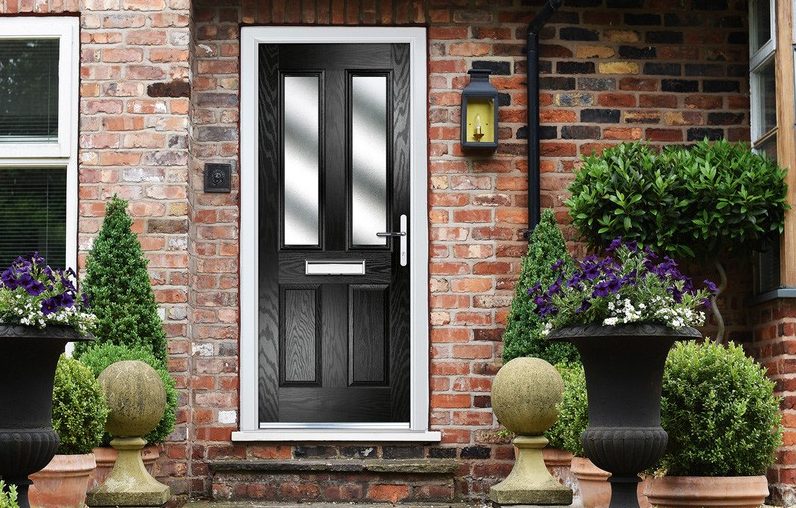A door latch is an indispensable tool designed to keep doors, gates and cupboards closed when not in use. They’re ideal for doors without a lock – but you’ll also find latches on locking doors, and latches can act as a lock itself.
You’ll find a range of latches and catches at Toolstation for any situation, whether you’re fitting a new loft latch or upgrading your gate hook. Look out for latches suitable for use outside or in harsh conditions and they’ll stand the test of time.
Latches can work in tandem with door locks and door closers to provide functionality and flexibility in domestic, industrial or commercial settings. For more information, check out our Door Lock Buying Guide.
Types of Door Latches

Tubular Door Latch
A tubular latch is a simple door latch commonly used with internal doors where a lock is unnecessary – or if the lock is a separate mechanism. It is operated with a handle or door knob, which releases the tapered ‘tongue’ of the latch from the door frame when the handle is pulled down or the knob is rotated. The latch is installed with the tapered tongue facing the strike plate in the door frame to ensure a smooth closure.
Tubular latches are easy to use and are widely available at a range of price points and styles. The tapered side of the latch means there’s no need to use the handle to close the door, and tubular latches can be used alongside door closers.
However, if you’re installing a tubular latch for the first time, you’ll need to cut a mortice into the door, which can be more challenging than installing a surface-mounted latch. Also, occasional maintenance is required to prevent potential stiffness in the latch.
Advantages
-
Easy to use
-
Widely available
-
Tapered edge means door can be pushed or pulled closed
Things to Consider
-
Mortice in door needed to install
-
Maintenance required to prevent stiffness

Deadbolt Door Latch
A deadbolt latch combines a lock and latch into a single unit, featuring a simple rectangular tongue that fits inside the strike plate in the door frame. It is commonly used in bathroom doors and can be operated with a thumbturn cylinder. Some deadbolt latches with a BS3621 rating are suitable for front doors, adding an extra layer of security and privacy.
Deadbolt latches enhance security and privacy where it’s needed, such as bathroom doors. They also have a simple design that can be used alongside thumbturn cylinders or keys.
However, deadbolt latches won’t keep a door closed unless it's locked, unlike tubular latches. Also, you’ll need to keep up with occasional maintenance to remove dust and debris which could cause the latch to get stiff. Make sure to check your deadbolt latch is BS3621 rated if you plan to use a deadbolt latch for home security.
Advantages
-
Enhanced security and privacy
-
Simple design
-
Can be used with thumbturn cylinders or keys
Things to Consider
-
Won’t keep a door closed unless it’s locked
-
Occasional maintenance required
-
Latch has to be BS3621 rated if being relied on for home security

Cabin Hook Latch
A cabin hook latch has a simple design where a metal hook is attached to one surface, and an 'eye' is attached to the other. The hook simply slots into the eye to keep it closed. This latch can be installed in different ways – parallel to keep doors closed, or in an opposite position to keep doors or windows open. While they’re mostly used for garden gates and sheds, they can also be used inside, such as for bathroom doors or to keep doors open.
Cabin hook latches are cost effective and easy to install. They’re also versatile, as you can use them to keep doors closed or opened – depending on how they’re installed.
However, cabin hook latches cannot be relied on as a security measure as they’re simply unhooked if you want to open the door. If securing a shed, you should combine them with a lock to keep thieves at bay. Also, cabin hook latches cannot be opened from the inside.
Advantages
-
Cost effective
-
Easy to install
-
Versatile installation options
Things to Consider
-
Cannot be relied on as a security measure
-
Cannot be opened from the inside

Sliding Bolt Door Latch
A sliding bolt latch is a common type of latch with a straightforward design – a sliding bolt moves across the door and slots into the holder on the door frame. They can be used indoors or outdoors depending on the material and properties, and are commonly used on bathroom doors, shed doors and gates.
Sliding bolt latches are easy to install and use. They are also widespread, so you’ll easily find a range of sizes, materials and styles – no matter your budget.
However, sliding bolt latches are not a type of robust security measure; their primary purpose is to keep doors closed and offer privacy. Also, over time, without proper maintenance or perfect installation, the bolt may become stiff or challenging to use. To avoid this, keep them clean and free from dust and debris.
Advantages
-
Easy to install
-
Easy to use
-
Widely available
Things to Consider
-
Not a security measure
-
May become stiff over time without maintenance or if installed incorrectly

Chain Door Latch
A chain latch allows the door to be opened slightly, allowing users to communicate while maintaining a layer of security. The design is simple – a chain is fitted to the door frame which slots into a holder on the back of the door. The chain allows a couple of inches of room for the door to open but cannot be unhooked from outside. They’re commonly used on front doors as an extra security measure, and can also prevent young children from fully opening the door.
The main advantage of chain latches is the extra layer of security they can provide – which is especially ideal for the elderly and the vulnerable. They’re also easy to install.
However, chain latches should not be relied upon as an alternative to a door lock, as it serves as a second layer of protection only.
Advantages
-
Extra layer of security
-
Especially ideal for elderly & vulnerable users
-
Easy to install
Things to Consider
-
Make sure to keep the door locked if you’re after robust security

Gravity Door Latch
Typically mounted on the inside of gates, gravity latches consist of a ‘bolt’ that permanently sits across the gate and frame, and a hook that is lifted to free the bolt. You’ll find gravity latches are self-latching so you don’t need to ensure they close – the bolt simply lifts the hook up when the gate is closing and traps itself.
The main advantage of a gravity latch is that they’re self-latching, and they’re very easy to use – simply lift the latch to free the bolt.
However, users should be aware that it cannot be opened from the outside unless it is installed on a short gate that you can reach over. Also, if the gate is forced while the latch is closed, it could potentially cause damage to the gate and the latch, as the timber may snap or bend. Without proper installation, or if the gate doesn't sit perfectly in the frame, the gravity latch may not work as effectively.
Advantages
-
Self latching mechanism
-
Easy to use
Things to Consider
-
Cannot be opened from the outside
-
Forcing the gate while the latch is closed could cause damage
-
Must be installed correctly to ensure effectiveness

Gate Latch
A gate latch uses a rectangular 'bolt' which is lifted up and down using a handle or ring to sit in a 'catch.' When lifted, the gate can be opened, and when let down, it is held in place, ensuring the gate remains closed.
Gate latches are simple to use and install, and provide a straightforward way of keeping a gate closed securely. They’ll withstand extreme weather so you won’t need to worry about your gate flying open in the middle of the night and causing damage.
Similar to gravity latches, they cannot be opened from the outside unless they’re installed on a short gate. You’ll also find that improper installation may lead to stiffness or reduced effectiveness – make sure the gate latch is level and the gate fits perfectly in the frame.
Advantages
-
Simple to use
-
Easy to install
-
Can withstand extreme weather conditions
Things to Consider
-
Cannot be opened from the outside
-
Improper installation can limit effectiveness

Night Latch
Also known as a Yale lock, a Night Latch is a type of lock with its locking mechanism installed on the surface of the door. The 'catch' or door jamb holds a tapered ‘tongue’ when the door is closed. Cupboard latches share the same design but are smaller and used for keeping cupboards closed.
Night latches and cupboard latches are ideal if you want a layer of security included with your latch. They are designed to self-latch, which ensures the door shuts securely behind you. The snib can also lock it in an open position when needed.
Night latches should only be used as supplementary security – they are not suitable for protecting against intruders on their own.
Advantages
-
Lock and latch in one unit
-
Self-latching mechanism
-
Snib can keep the door open when needed
Things to Consider
-
Should only be used as supplementary security

Spring Latch
A spring latch uses a spring to hold a bolt in position and keep a door or gate closed. They automatically spring back to the closed/locked position, resembling a pinball machine. Spring latches are commonly used outside on gates or shed doors.
Spring latches are easy to use and have a robust design, especially compared to some other gate latch alternatives.
However, dust and debris can accumulate in the spring which may reduce its effectiveness, and make the latch stiff. Keep the lock clean and free from debris to keep it working well. Also, as the spring is open and on display, it could be at risk of damage compared to latches that keep the mechanism housed inside a unit.
Advantages
-
Easy to use
-
Robust, long-lasting design
Things to Consider
-
Must be well maintained to ensure effectiveness
-
Spring could be at risk of damage

Magnetic Catch
A magnetic catch uses magnetic connection to keep doors closed. One half is installed on the door frame, while the other is installed on the door itself. As the door is closed, the magnetic field pulls them together, keeping the doors in position. Magnetic catches are most commonly used on cupboard doors.
Magnetic catches are easy to use and do not need a separate handle to operate – simply open and close the door. They are inexpensive, easy to install, and have a durable design with no moving parts that can become stiff. Magnetic catches also have a sleek, hidden design which makes them perfect for cabinet doors.
Make sure to choose a magnetic catch that is suitable for the weight of the door. Heavier doors will need stronger catches to keep them closed, as the weight from the door can overwhelm the magnetic field.
Advantages
-
Easy to use, install and maintain
-
Inexpensive
-
Sleek, hidden design
Things to Consider
-
Make sure the magnet is strong enough for the specific door

Loft Latch
Loft latches are used by pushing the loft hatch upwards, which releases the latch from the catch and allows the door to open. To close the loft hatch, simply push it upwards again until the latch engages. Loft latches, as the name suggests, are most commonly used in lofts – but they’re versatile and can also be used in cupboards.
The touch mechanism makes loft latches easy to use without the need for knobs and handles – making them ideal if you’re after a sleek design.
However, over time, dust, debris, and natural shifting of the latch could cause it to become loose or stiff. Regularly maintaining the loft latch can prevent these issues.
Advantages
-
Can also be used in cupboards
-
Easy to use mechanism
-
Hidden design
Things to Consider
-
Maintenance needed to ensure effectiveness

Roller Bolt Catch
Roller bolt catches use a ball that slides into the striking plate rather than a tapered 'tongue’ like a tubular latch. Instead of a lever handle, it requires a firm pull to open, making it suitable for cupboards, especially airing cupboards.
Roller bolt catches provide a secure hold and are easy to use. They only need a pull handle rather than a lever handle to operate, which offers greater flexibility.
However, roller bolt catches may get stiff or loose over time because timber doors may be affected by different conditions such as humidity or low temperatures. The timber can expand and contract which may stiffen or loosen the roller bolt in the striking plate. Also, roller bolt catches, like tubular latches, need to be installed in a mortice in the door.
Advantages
-
Secure hold
-
Easy to use
-
Pull handle offers style flexibility
Things to Consider
-
Effectiveness may be reduced due to changes in timber door
-
Require a mortice to be installed

Twin Roller Catch
Twin roller catches have two small rolling cylinders that separate as a tapered metal plate slides between them. The rolling cylinders catch the plate and hold it in place – when opening the door, there will be some resistance from the secure hold. Similarly, a double ball catch uses two rolling ball bearings to hold a metal bolt in place. Twin roller catches are commonly used in cupboards, such as kitchen cabinets or airing cupboards.
Twin roller catches and double ball catches offer a secure hold and add resistance which makes them a good option for childproofing cupboards. They are easy to install as they don’t need to be fitted into a mortice in the door.
However, users should be aware that maintenance is required to keep the rolling cylinders or ball bearings free from dust and debris so they continue to work effectively.
Advantages
-
Added resistance is ideal for childproofing
-
Secure hold
-
Easy to install
Things to Consider
-
Maintenance required to ensure effectiveness
Key Door Latch Considerations
Colour
Choose between silver, black and gold latches to complement your style. Pair with matching coloured door handles to elevate the look of your door.
Finish
Polished and satin door latches offer a soft, smooth finish. Brushed finish latches are similar, but with slightly more texture that gives a matt appearance. Antique latches are purposefully weathered for a traditional, elegant style.
Material
Most interior door latches will be made of nickel, which is lightweight and relatively low cost. However, outdoor latches need to withstand the elements and harsher conditions, so stainless steel is more commonly used.
Size
Finally, there are a range of different size latches. Generally, larger latches are better suited to larger gates and heavy doors – while small latches are best for cupboards or lightweight interior doors.



















